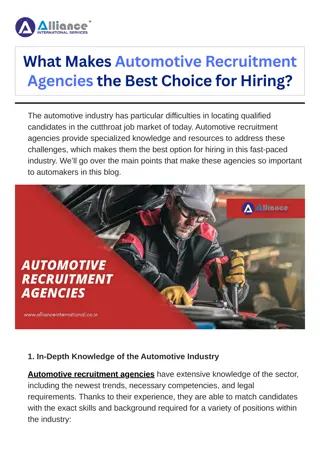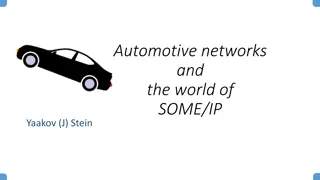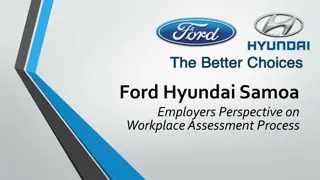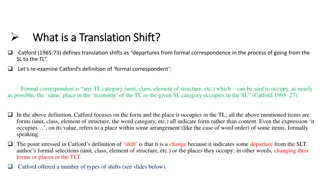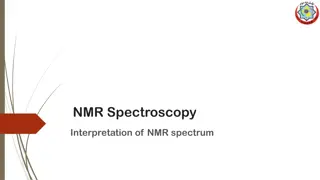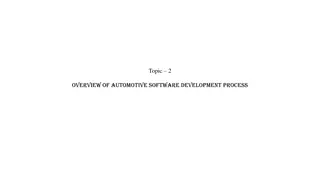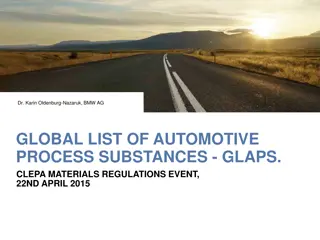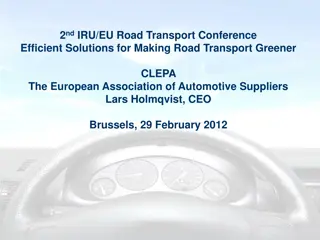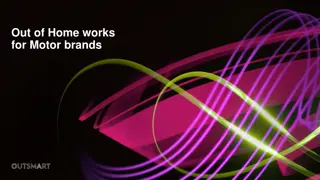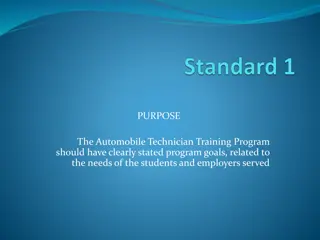Technological Shifts in the Automotive Industry: A Modeling Approach by Sergey Milyakin
This study explores the impact of technological shifts in the automotive industry through coefficients modeling, analyzing trends such as energy use, composite materials, digitalization, and autonomous driving. The assessment methodology differentiates between existing and upcoming technological changes, providing insights into the future of automobile production. The analysis reflects changes in chemistry, ferrous metals, nonferrous metals, and composite materials, forecasting a shift towards light and energy-efficient materials. Furthermore, it discusses changes in gasification, coal usage, and the rise of autonomous driving and digital services in the industry.
Download Presentation

Please find below an Image/Link to download the presentation.
The content on the website is provided AS IS for your information and personal use only. It may not be sold, licensed, or shared on other websites without obtaining consent from the author.If you encounter any issues during the download, it is possible that the publisher has removed the file from their server.
You are allowed to download the files provided on this website for personal or commercial use, subject to the condition that they are used lawfully. All files are the property of their respective owners.
The content on the website is provided AS IS for your information and personal use only. It may not be sold, licensed, or shared on other websites without obtaining consent from the author.
E N D
Presentation Transcript
IO Coefficients Modeling in the Automotive Industry Sergey Milyakin INFORUM, 2021
1. Introduction and methodology
Technological shifts assessment methodology Exited shifts: New or expected shifts: 1.Already happening 1. Will happen possibly 2. Observable in the past 2. Not observable in the past 3. Econometrical approach 3. Scenario analysis Examples: 1. Energy use 2. Composite materials 3. Digitalization Examples: 1. Electric cars 2. Fully autonomous driving 4. Partly autonomous driving 3
Reflection of the shift In Automobile and automobile equipment production From Chemistry (red, left axe) Relation Chemistry / Ferrous metals From Ferrous metals (blue, right axe) +30% 4
Relation analysis Chemistry Ferrous metals Nonferrous metals Metal products Chemistry Ferrous metals Nonferrous metals Metal products 5
Relation analysis Chemistry Ferrous metals Nonferrous metals Metal products Chemistry Composite materials spread Ferrous metals Light materials spread Light or composite materials spread Light or composite materials spread Nonferrous metals Metal products 6
Technological shifts in Automobile industry 1. Gasification and coal usage decline 2. Composite and light materials spread (energy efficiency growth) 3. Partly autonomous driving and saloon comfort rise 4. Digitalization and services share growth 7
2. Gasification and coal usage decline
Gasification and coal usage decline Gas Coal Petroleum products Electricity Gas Coal Petroleum products Electricity 9
Gasification and coal usage decline Gas / Coal Gas / Petroleum products +215% +118% 10
3. Composite and light materials spread
Composite and light materials spread Chemistry Ferrous metals Nonferrous metals Metal products Chemistry Ferrous metals Nonferrous metals Metal products 12
Composite and light materials spread Nonferrous / Ferrous Chemistry / Ferrous+30% +59% 13
Composite materials vs. Ferrous Metals From Chemicals to Automobiles & equipment / From Ferrous metals to Automobiles & equipment Relation (red line, left axis) Relation (red line, left axis) Investments in Automobile industry (blue line, right axis) Accumulated investments since 2000 with zero retirement (blue line, right axis) 14
Composite materials vs. Ferrous Metals From Chemicals to Automobiles and equipment / From Ferrous metals to Automobiles and Predicted (red line, left axis) equipment +19% 2030/2017 Actual(blue line, right axis) 15
Composite materials vs. Ferrous Metals From Chemicals to Automobiles and From Ferrous metals to Automobiles and equipment equipment 16
4. Partly autonomous driving and saloon comfort rise
Partly autonomous driving and saloon comfort rise Electric equipment Telecommunicati on equipment Machinery Automobiles equipment Electric equipment Telecommunication equipment Machinery Automobiles equipment 18
Partly autonomous driving and saloon comfort rise Electric equipment / Automobile equipment Telecommunication equipment / Automobile equipment +22% +66% 19
Partly autonomous driving and saloon comfort rise From Electric equipment to Automobiles & equipment / From Automobiles & equipment to Automobiles & equipment Relation (red line, left axis) Relation (red line, left axis) Investments (blue line, right axis) Investments with 2 years lag (blue line, right axis) 20
Partly autonomous driving and saloon comfort rise From Electric equipment to Automobiles & equipment / From Automobiles & equipment to Automobiles & equipment +25% 2030/2017 Predicted (red line, left axis) Actual (blue line, right axis) 21
Partly autonomous driving and saloon comfort rise From Automobile equipment to Automobiles & equipment From Electric equipment to Automobiles & equipment 22
5. Digitalization and services share growth
Digitalization and services share growth ICT Services Trade Transport ICT Services Trade Transport 24
Digitalization and services share growth ICT / Transport ICT / Trade +248% +346% 25
Digitalization and services share growth From ICT to Automobiles & equipment / From Transport to Automobiles & equipment Relation (red line, left axis) Relation (red line, left axis) Accumulated investments since 2000 with zero retirement Investments (blue line, right axis) (blue line, right axis) 26
Digitalization and services share growth Predicted (red line, left axis) +49% 2030/2017 Actual(blue line, right axis) 27
Digitalization and services share growth From ICT to Automobiles & equipment From Transport to Automobiles & equipment 28
6. Effects and conclusion
Macro (constant 2010 prices, mln. rub) New (red line) Old (blue line) GDP Investments 30
Macro (constant 2010 prices, mln.rub) New (red line) Old (blue line) Output in Automobiles Output in Transport 31
Macro (constant 2010 prices, mln.rub) New (red line) Old (blue line) Output in ICT Output in Chemicals 32
Conclusions and future plans 1. Technological shifts are to be divided in two groups: existed and expected 2. Relation of IOCs might be a reflection of technological shift 3. There was underlined four main blocks of technological shifts in automotive industry 4. Possible shifts were modeled with RIM 5. Technological shifts might significantly influence industries outputs 6. Effect for macroparameters is insignificant in this assessment 1. To develop approach with scenario approach: how cost structure can change within inertia 2. To multiply this approach to other industries 33
Contacts www.ecfor.ru / milyakin milyakinsergei@gmail.com






